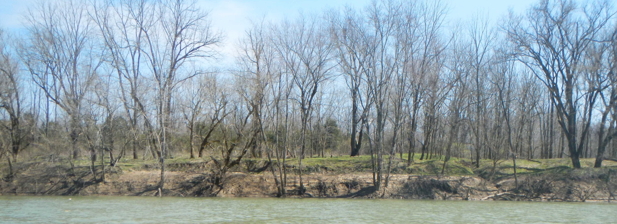Fluvial geomorphologists, along with hydrologists and river engineers, have long been concerned with the flows or discharges that are primarily responsible for forming and shaping river channels. In the mid-20th century it was suggested that this flow is associated with bankfull stage—the stage right at the threshold of overflowing the channel—and that this occurs, on average, about every year or two in humid-climate perennial streams. If you have to choose just one flow to fixate on—and sometimes you do, for various management, design, and assessment purposes—and have no other a priori information about the river, bankfull is indeed the best choice. But, of course, nature is not that simple.
Some streams have more than one (range of) discharge(s) that are critical in forming or maintaining the channel. Some channels and some discharge regimes are in the process of changing or adjusting to new environmental constraints, such that the whole idea of a single formative discharge is a moving target. Some streams undergo cycles—or perhaps episodes is a better word—of channel infilling and excavation. Sometimes, even within humid temperate climates, the bankfull flow does not correspond with a 1- to 2-year recurrence interval. And where it does, it is typically so only when you calculate it using the annual maximum discharge, not using partial duration, daily, or other series.

Banks of the Kentucky River
Without even going into streams in other climate regimes, or bank geometry that makes it difficult in some cases to define exactly where the bank tops are, you have compound channels. Here major incision events or episodes create a large macrochannel, with inset floodplains or benches defining a smaller channel within (no doubt there other scenarios for compound channels, too).
The relationship between bankfull flow and the year-or-two mean recurrence interval has become so entrenched that there exist techniques designed to identify a “bankfull” level within incised channels where the expected recurrence interval discharge does not correspond with the bank tops (incidentally, that’s why I use the term banktop flow to avoid confusion).
Anyway, a couple years ago I did a study looking at threshold discharges along a 681 km reach of the lower Brazos River, Texas, for thalweg connectivity (to maintain continuous downstream flow), bed inundation (the entire river bed is inundated), high but sub-banktop flows, channel-floodplain connectivity stages (where water is exchanged between the channel and floodplain, and overbank flow. I also estimated thresholds for transport of sand bed forms and medium gravel, and for cohesive bank erosion. The article based on that study just came out in Hydrological Sciences Journal.
I’ve pasted in the abstract below, but the headline is that no single flow is dominant either hydrologically or geomorphically, and the one to two-year flood has no special significance. Also, due to backwater flooding of tributaries, high-water subchannels that are activated by sub-banktop stages, and occasional gaps in the natural levee, channel-floodplain connectivity occurs at much lower discharges than overbank flooding.
I know from my own studies and experience that these phenomena also occur in other rivers of the region, and from the literature that there are many streams where no single flow is dominant. It will be interesting to see where future studies of reference, critical, threshold, or channel-forming flows take us.



